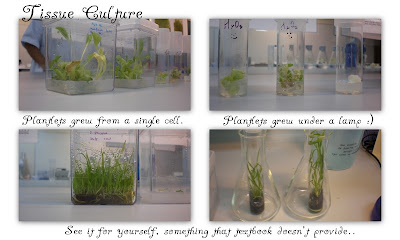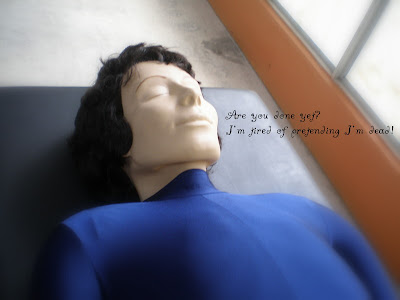I attended two workshops today mainly biotechnology and medical health sciences.
Venue: INTI University College Nilai
Time: 10.30-12.30/1.00-3.00
Dress Code: Casual
Price: Nought (priceless)
I attended the biotechnology first. I was lucky because there were no other participants except me so I had a great time with all the lecturers :)
Lalita, the lecturer for microbiology(if I'm not mistaken) taught me about microorganisms like bacterias. Iwas delighted as I was welcomed by 6 plates of nutrient agar containing cultured bacterias. Three of them that were swabbed beautifully caught my attention.
 Yes indeed. It is much prettier and much more creative than plain banners. I was given a chance to culture a type of bacteria named escherichia coli (lived in the human intestine) by swabbing my name onto a sterilised nutrient agar (it needs at least 24 hours for the words to appear)...Lalita says she will send me the pictures later.
Yes indeed. It is much prettier and much more creative than plain banners. I was given a chance to culture a type of bacteria named escherichia coli (lived in the human intestine) by swabbing my name onto a sterilised nutrient agar (it needs at least 24 hours for the words to appear)...Lalita says she will send me the pictures later.*Tips: Always sterilise the apparatus before using it. In this case, heat is needed. Also, make sure you dispose the apparatus used in the correct way. They have special pressure machine to treat the wastes before throwing them as usual dumps. Wrong disposal can harm lots of people.
 Next, I was taught about bacteria living in all parts of our body. The armpit regions especially are filled with them...that’s what I saw on the petri dishes...revolting I know... Some other places such as the tongue, skin and nasal region also has lots of them. Lalita called me to leave a sample of my body swabs to either choose between the tongue or skin and of course...did you expect me to swab my tongue?
Next, I was taught about bacteria living in all parts of our body. The armpit regions especially are filled with them...that’s what I saw on the petri dishes...revolting I know... Some other places such as the tongue, skin and nasal region also has lots of them. Lalita called me to leave a sample of my body swabs to either choose between the tongue or skin and of course...did you expect me to swab my tongue? Yeah, Biology students! I’m sure that you guys knew about tissue culture as read in the textbook. Lalita taught me about it as well...I had a chance to culture that small piece of sterilised cauliflower. It has to be done in a sterilised chamber. Sterilised in this case meant to dip or clean with alcohol and then heated. For plants sterilisation, however, there’s a special procedure that we’ll have to follow.(click on the picture above to learn more)
Yeah, Biology students! I’m sure that you guys knew about tissue culture as read in the textbook. Lalita taught me about it as well...I had a chance to culture that small piece of sterilised cauliflower. It has to be done in a sterilised chamber. Sterilised in this case meant to dip or clean with alcohol and then heated. For plants sterilisation, however, there’s a special procedure that we’ll have to follow.(click on the picture above to learn more) These are some of the chemical used. The reason they sterilise is because they don’t want it to be contaminated and for your information, the nutrient agar and the cell are very nutritious.
These are some of the chemical used. The reason they sterilise is because they don’t want it to be contaminated and for your information, the nutrient agar and the cell are very nutritious. See how pretty they are. The cultured plants need to be placed under a lamp and ambient temperature so that it will grow... leaves it away from the soil for the time being.
See how pretty they are. The cultured plants need to be placed under a lamp and ambient temperature so that it will grow... leaves it away from the soil for the time being.Mr Wong, a biochemistry lecturer taught me how to immobilise enzymes. I was pretty unclear at first but now I’d understand. The reason why they immobilise the enzymes is because in order to produce and to ensure a large amount of product formed from a constant number of substrate, enzyme has to be fixed into position so that all the substrate, by hook or by crook has to pass through the enzyme in order to move and when it passes through the enzyme they eventually becomes products. First, sodium alginate is mixed with enzyme (peroxide, I think) then it is filled in a syringe and is clamped 20cm above a beaker. The beaker is filled with calcium chloride (to seal the droplets) and it is then placed onto a magnetic stirrer. The mixed solution in the syringe is slowly pressed down drop by drop into the beaker and you’ll be able to see small balls like the ones you can see in an aquarium... it’s cute I tell you. The beads and the calcium chloride solution is filled into a bed column and it is filtered. When you pour substrate solution into the column, the solution flowing out of the end of the column will be reddish-pink, just like the colour of manganese ion, but if you pour calcium chloride again to wash, it will return to its original colour.
 Nisha, the lecturer (sorry I forgotten what lecturer she was), taught me how to solve a crime using DNA fingerprinting.
Nisha, the lecturer (sorry I forgotten what lecturer she was), taught me how to solve a crime using DNA fingerprinting. I was supplied with hi-tech pipettes (unlike the school ones with a big bulb on). It’s great to learn how to use that apparatus :)
I was supplied with hi-tech pipettes (unlike the school ones with a big bulb on). It’s great to learn how to use that apparatus :)
Not forgetting the DNA samples. The DNA samples are stored under low temperatures and it will be treated with restriction enzymes (cleves the DNA into smaller segments of different sizes) and a type of dye before it is taken to the next step. I’d to suck up each DNA samples and load them into respective wells in the gel. That gel is placed in between the buffer (consist of unknown recipe but mainly electrolyte) and is placed in between the electrodes of different terminals.
The perfect voltage is 90V and the duration is about 30-45 minutes. FYI, DNA are negatively charged so it has to be placed in wells near the negative electrode. When the switch is turned on, the lighter segments will move forward faster than the heavier ones towards the positive electrode. Then all you can see is this.
 Now, by comparing the bands, can you tell me who killed sponge bob? (Make a guess, I’ll reveal it later, do make a guess at the cbox on your right).
Now, by comparing the bands, can you tell me who killed sponge bob? (Make a guess, I’ll reveal it later, do make a guess at the cbox on your right).That wrapped up my biotechnology workshop... well, it ended with photography session.
 Lalita & I
Lalita & I Nisha & I
Nisha & I Mr Wong & I
Mr Wong & IThanks :)

Aha, that handsom man over there actually atracted my attention during my first stop in the medical workshop later that afternoon. He has human texture, bones and gesture...I called him Romeo :) As what the lecturers said, Romeo has many fans from all over the campus, especially when it comes to X-raying him :) You gotta admit that he's FIT!
 He just has that pleasant look, unlike the skeleton we have in our biology lab :)
He just has that pleasant look, unlike the skeleton we have in our biology lab :) This is X-ray film displayed on a X-ray box. Did you know that the pictures taken can be edited so that doctors can see the bone fractures or deformation clearly. There's a special software named NAOMI :) This was actually one branch of medicine named radio..(something that deals with X-ray, mamography and CT scan)
This is X-ray film displayed on a X-ray box. Did you know that the pictures taken can be edited so that doctors can see the bone fractures or deformation clearly. There's a special software named NAOMI :) This was actually one branch of medicine named radio..(something that deals with X-ray, mamography and CT scan) Yes, I had another hands-on. This time I did what a pharmacist can do...making calamine lotion. It was great fun but I hate that glove I was wearing...it reminds me of Chemistry SPM 2009 paper 1...ergh, that vulcanized rubber! :)
Yes, I had another hands-on. This time I did what a pharmacist can do...making calamine lotion. It was great fun but I hate that glove I was wearing...it reminds me of Chemistry SPM 2009 paper 1...ergh, that vulcanized rubber! :)*Facts: Calamine lotion is made up of calamine powder, zinc oxide powder, bauxite powder, sodium citrate, glycerine and distilled water. Calamine powder for creamy, moisture and protection properties; zinc oxide and bauxite has sunscreen protection properties; glycerine for moisture and sodium citrate for maintaining the pH of the lotion.
The fun part was I got to bring the lotion that I did back home to use...nah, not gonna use it...do you think I wanna risk my life on it? :) I get to test the hardness of tablets and even better, to bring lactose tablets home as souveniours :) I had chance to see the liver cells of rats before and after it consumed panadol in excess. I also got to see how lab experties prepare the liver cells as slide under microscope.
Overall, it was the best exposure and I learnt a lot of things... At least now, I have a gist of what I'll be doing in the near future... I enjoyed my day...
Last but not least, I would like to wish my favourite chemistry teacher, HAPPY BIRTHDAY!
Hope you enjoyed your day!








No comments:
Post a Comment